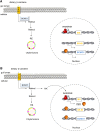Provitamin A metabolism and functions in mammalian biology
- PMID: 23053549
- PMCID: PMC3471205
- DOI: 10.3945/ajcn.112.034629
Provitamin A metabolism and functions in mammalian biology
Abstract
Vitamin A deficiency is a major public health problem in developing countries. Some studies also implicate a suboptimal vitamin A intake in certain parts of the population of the industrialized world. Provitamin A carotenoids such as β-carotene are the major source for retinoids (vitamin A and its derivatives) in the human diet. However, it is still controversial how much β-carotene intake is required and safe. An important contributor to this uncertainty is the lack of knowledge about the biochemical and molecular basis of β-carotene metabolism. Recently, key players of provitamin A metabolism have been molecularly identified and biochemically characterized. Studies in knockout mouse models showed that intestinal β-carotene absorption and conversion to retinoids is under negative feedback regulation that adapts this process to the actual requirement of vitamin A of the body. These studies also showed that in peripheral tissues a conversion of β-carotene occurs and affects retinoid-dependent physiologic processes. Moreover, these analyses provided a possible explanation for the adverse health effects of carotenoids by showing that a pathologic accumulation of these compounds can induce oxidative stress in mitochondria and cell signaling pathways related to disease. Genetic polymorphisms in identified genes exist in humans and also alter carotenoid homeostasis. Here, the advanced knowledge of β-carotene metabolism is reviewed, which provides a molecular framework for understanding the role of this important micronutrient in health and disease.
Figures




References
-
- Demmig-Adams B, Adams WW., III Antioxidants in photosynthesis and human nutrition. Science 2002;298:2149–53 - PubMed
-
- Bernstein PS, Yoshida MD, Katz NB, McClane RW, Gellermann W. Raman detection of macular carotenoid pigments in intact human retina. Invest Ophthalmol Vis Sci 1998;39:2003–11 - PubMed
-
- Krinsky NI, Landrum JT, Bone RA. Biologic mechanisms of the protective role of lutein and zeaxanthin in the eye. Annu Rev Nutr 2003;23:171–201 - PubMed
Publication types
MeSH terms
Substances
Grants and funding
LinkOut - more resources
Full Text Sources
Medical

